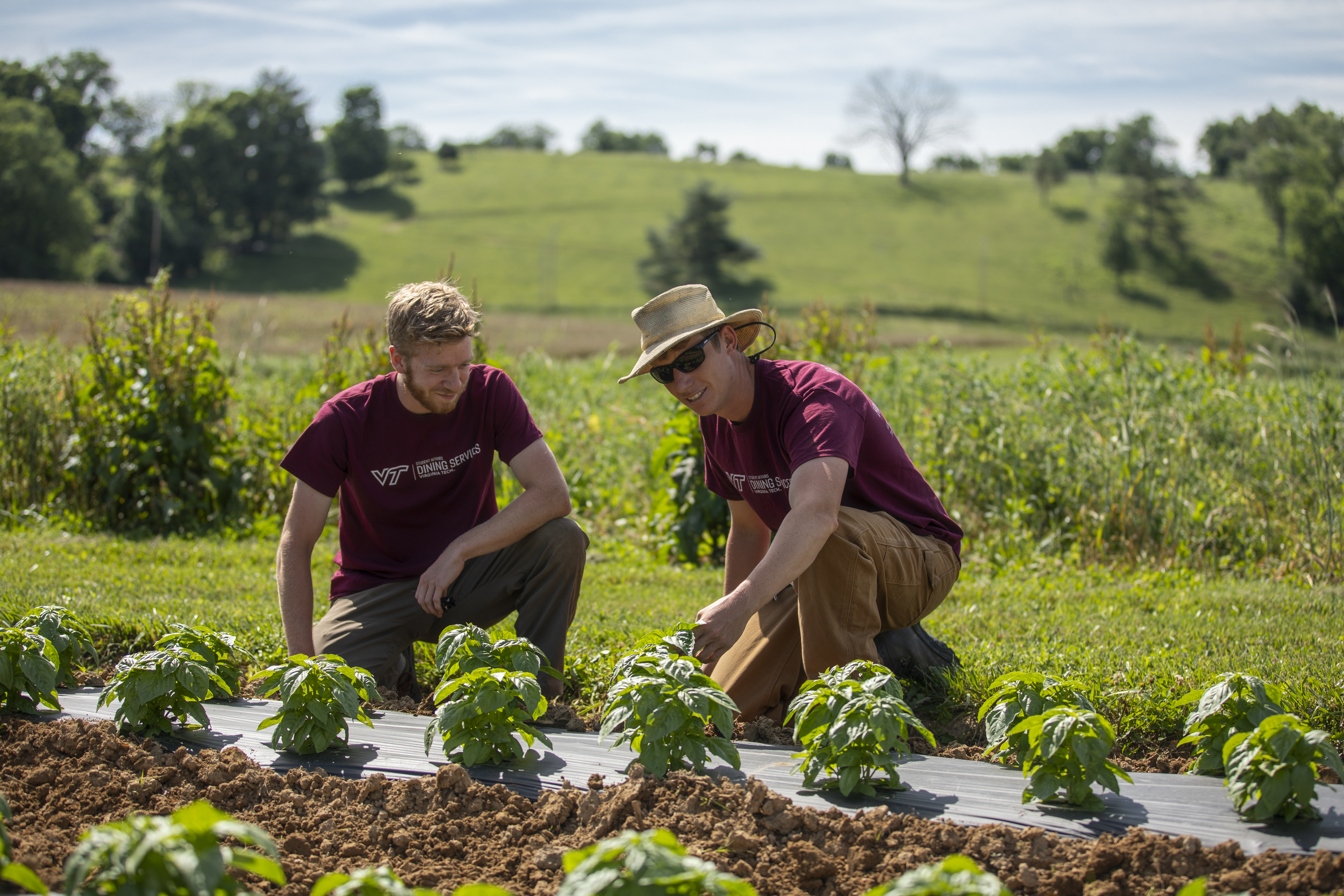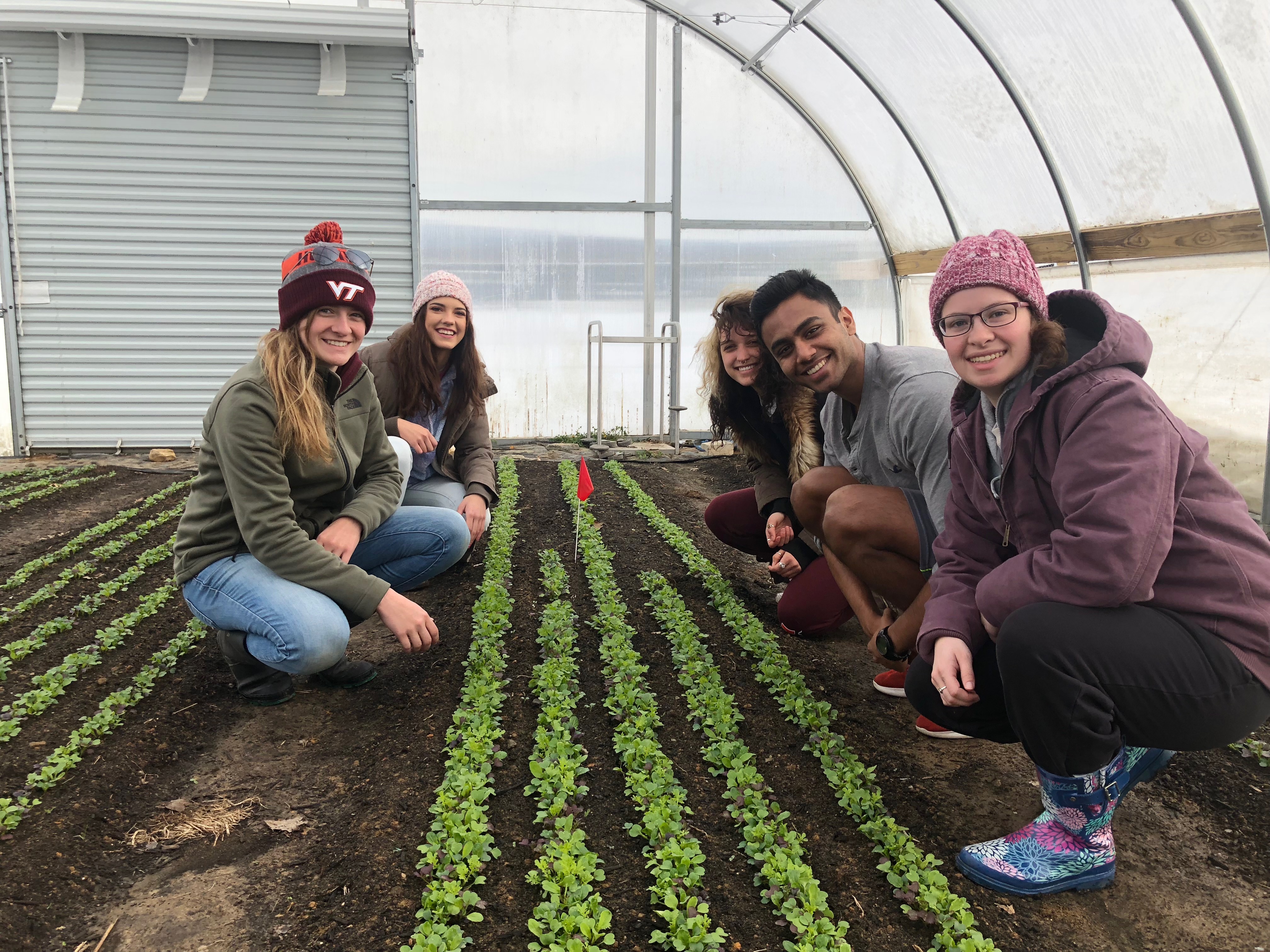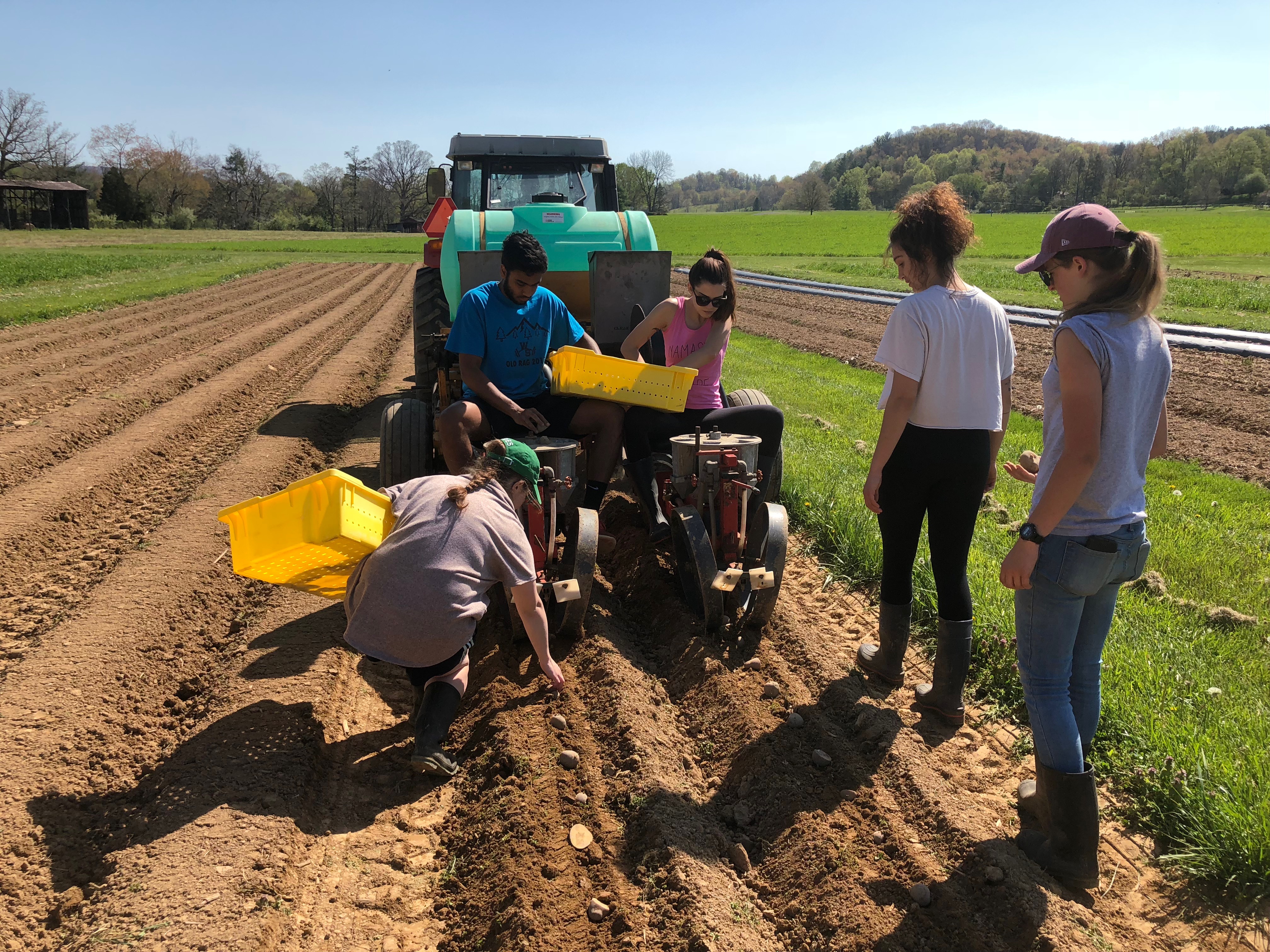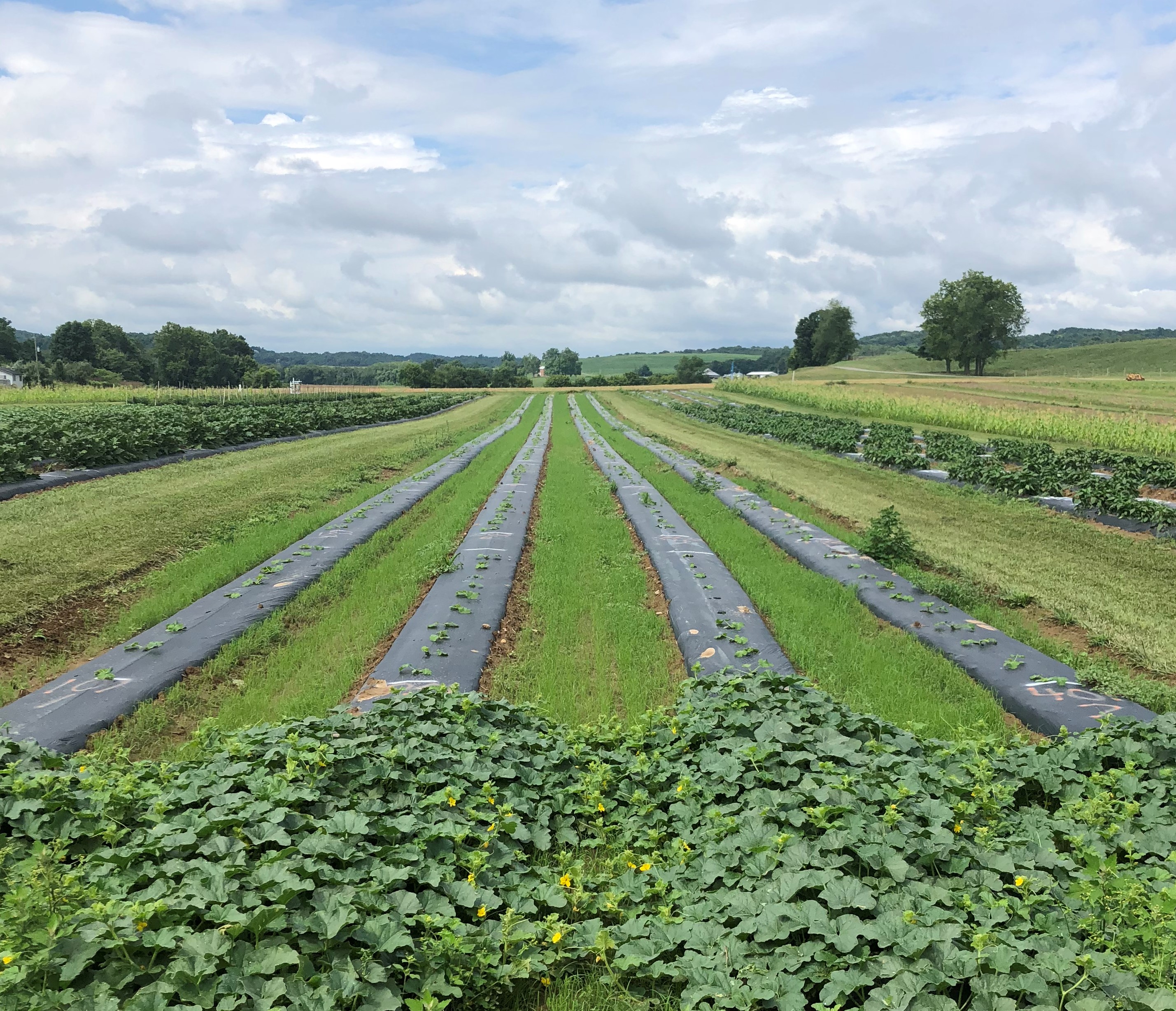
Oct 31, 2018
Researching, teaching, growing, Homefield Farm operates seamlessly
Virginia Tech senior Riley Golski doesn’t look at the dining hall’s green beans the same way he did as a freshman.
A geography major at the university who grew up in Norfolk, he had no experience in farming or gardening but became interested in food production while involved with environmental groups on campus. That interest lead to taking a Sustainable Agriculture Practicum class in the fall of 2017, where he learned, hands-on, the challenges of operating a small-scale sustainable farm connected to the university. That course led to a summer job in 2018 on the same farm.
Now, when he walks into a campus dining hall, he recognizes the beans as the same vegetables he spent hours of the previous day picking. The experience has deepened his perspective on food production.
“I think a lot of people that don’t have experience working in production don’t have a handle on how hard it is to do different things,” he said. Chemical sprays still seem undesirable to him, but for small farmers protecting their livelihood, “the lines aren’t so black and white,” he said.
Homefield Farm at Virginia Tech University offers a seamless mesh of research, education, and actual farm production. A joint venture of the university’s Dining Services and College of Agriculture and Life Sciences, the farm produces vegetable crops for the campus dining centers, gives students experience in the field, and allows researchers to test new methods of integrated pest management.
Cultivation classroom

Alex Hessler is the farm director, managing all three aspects of the farm production and use. But he also is a teaching employee. Holding a master’s degree in integrated plant and soil sciences from the University of Kentucky, he teaches a Sustainable Agriculture Practicum for the university. The practicum class teaches seeding and transplanting, weed management, pest control and soil fertility management.
“Students observe the impact of pests on crops. … They understand the impact of proper fertility,” he said. “Many of the students who have taken the class have gone on to work on farms, even large farms out of state.”
Homefield Farm was established in 2009 with funds from a USDA Higher Education Challenge grant that established the Civic Agriculture and Food Systems minor at the university. At that point the farm was really just a large garden, about 1/20th of an acre, located 10 miles from campus. Today, the farm has expanded to 6.5 acres and is a significant supplier of the university’s food service.
Farm to table

Virginia Tech Dining Services provides much of the farm’s operating funds, and so the farm is plugged into its demands.
“We have a really intimate relationship with the chefs and procurement personnel in the dining halls who are making their menus,” he said. “Over the years, we’ve narrowed down our crop selections to those items that we can grow well and that help tell the story of farm-to-campus dining because they are unique and exciting.” Rather than grow simple baking potatoes, they often grow purple fingerling potatoes that look attractive in the cafeteria setting.
The field plantings at the farm are supplemented by a 30-by-90-foot high tunnel that is used to produce transplants, summer tomatoes and greens for the spring semester.
During the summer, there are fewer students to feed, so the farm takes on a different tack, growing storage crops like potatoes, sweet potatoes, winter squash and pumpkins. They also grow basil, parsley and a cilantro that are processed, blended with oil and frozen. “We do try to feature more traditional summer crops during the four-week period in July when student orientation is taking place and parents and students are eating in the dining center,” Hessler said. For that spread, the farm puts out sweet corn, green beans, potatoes and carrots.
In the fall, the group produces more common crops such as brassicas, carrots and beets.
Getting technical

All crops are grown on 6-foot wide beds straddled by tractors. Bare-ground plantings are grouped in two rows spaced 32 inches apart, or three rows spaced 16 inches apart. Black plastic is used for long-season, heat-friendly crops. The farm makes use of a variety of mechanized equipment such as a finger weeder, a flex-tine weeder, an R.J. mechanical transplanter and a potato healer. The farm is split into 1/3-acre blocks that are each 400 feet long.
“The precision transplanting and direct seeding allows us to do most of our cultivation mechanically,” Hessler said. “What’s fun about our operation is, we’re fairly small, but because we’ve streamlined our system, we’re able to justify using equipment you might see on a larger farm. That really boosts our efficiency, which means that during the semester we get to spend more time with students doing field walks, discussion and learning and we don’t need to spend all our time on our knees weeding carrots.”
The farm is also a site for university research projects.
“There are faculty members and graduate students in other departments throughout the College of Agriculture and Life Sciences that integrate research projects into our production fields,” Hessler said.
Specifically, the Homefield Farm last year worked with entomologist Tom Kuhar to conduct experiments on an IPM technique involving the use of living mulches in tomato production.
Homefield Farm hasn’t used synthetic pesticides or fertilizers for 10 years and is in the process of applying for organic certification. The farm is also in the process of implementing Good Agricultural Practices (GAPs) to prepare for a GAP food safety audit.
For Golski and many of the other students, farming is a new experience.
“I grew up in the city,” Golski said. “I didn’t have any experience farming or even gardening.” He’s struck by the amount of planning that goes into decisions about how much to grow, how to deliver the crops on time to meet demand, and how to monitor water quality.
“And of course,” he added, “It’s a lot of hard work often for not much reward.”
But he does feel a certain sense of accomplishment seeing his crops in the campus dining hall.
– Stephen Kloosterman, VGN Associate Editor
Top photo: Homefield Farm director Alex Hessler, right, and student crew member Riley Golski discuss harvesting basil, a crop processed in large quantities into pesto by Virginia Tech Dining Services.
Living mulches an alternative to plasticulture

“A lot of commercial vegetable production involves the use of raised beds covered by plastic mulch. This is especially true for fruiting vegetables like tomatoes, peppers and cucurbits. This system helps to suppress weeds, warms the soil in the spring, and enable efficient use of water via drip irrigation. However, growers continually have to battle weeds or muddy conditions with soil in the alleyways between the plastic-covered beds. The muddy conditions in alleyways can delay routine crop maintenance such as staking, stringing, spraying or harvesting operations. The muddy alleyways can also result in soil splash onto plant foliage, fruit, and harvest containers which has implications with regards to sanitation.
“In addition, soil erosion can occur during rain events. Personally, I need to manually visit my vegetable plots at least weekly, and muddy alleyways are a major impediment to my efficiency to do research on vegetable crops. Thus, the research on living mulches between the plasticulture beds was something that I was definitely interested in.
“In collaboration with Alex Hessler, we planted teff grass (Eragrostis tef ) between my plastic beds of vegetables: squash (see photo), melons, peppers and tomatoes, and compared it with plastic beds that we did not. There has been a huge reduction in the amount of weeds pressure, and the layer of grass is excellent to walk on, and enables us to even get into the field sooner following wet conditions. It is definitely something that I will continue with in future years. We will be interested to see if it also might have any impact on insect populations such as arthropod natural enemies.”
– Thomas P. Kuhar, Virginia Tech Professor and Extension Vegetable Entomology Specialist






